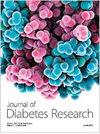Identification and Validation of the Pyroptosis-Related Hub Gene Signature and the Associated Regulation Axis in Diabetic Keratopathy
IF 3.6
3区 医学
Q2 ENDOCRINOLOGY & METABOLISM
引用次数: 0
Abstract
Background. Diabetic keratopathy (DK) poses a significant challenge in diabetes mellitus, yet its molecular pathways and effective treatments remain elusive. The aim of our research was to explore the pyroptosis-related genes in the corneal epithelium of the streptozocin-induced diabetic rats. Methods. After sixteen weeks of streptozocin intraperitoneal injection, corneal epithelium from three diabetic rats and three normal groups underwent whole-transcriptome sequencing. An integrated bioinformatics pipeline, including differentially expressed gene (DEG) identification, enrichment analysis, protein-protein interaction (PPI) network, coexpression, drug prediction, and immune deconvolution analyses, identified hub genes and key drivers in DK pathogenesis. These hub genes were subsequently validated in vivo through RT-qPCR. Results. A total of 459 DEGs were screened out from the diabetic group and nondiabetic controls. Gene Set Enrichment Analysis highlighted significant enrichment of the NOD-like receptor, Toll-like receptor, and NF-kappa B signaling pathways. Intersection of DEGs and pyroptosis-related datasets showed 33 differentially expressed pyroptosis-related genes (DEPRGs) associated with pathways such as IL-17, NOD-like receptor, TNF, and Toll-like receptor signaling. A competing endogenous RNA network comprising 16 DEPRGs, 22 lncRNAs, 13 miRNAs, and 3 circRNAs was constructed. After PPI network, five hub genes (Nfkb1, Casp8, Traf6, Ptgs2, and Il18) were identified as upregulated in the diabetic group, and their expression was validated by RT-qPCR in streptozocin-induced rats. Immune infiltration characterization showed that diabetic corneas owned a higher proportion of resting mast cells, activated NK cells, and memory-resting CD4 T cells. Finally, several small compounds including all-trans-retinoic acid, Chaihu Shugan San, dexamethasone, and resveratrol were suggested as potential therapies targeting these hub genes for DK. Conclusions. The identified and validated hub genes, Nfkb1, Casp8, Traf6, Ptgs2, and Il18, may play crucial roles in DK pathogenesis and serve as therapeutic targets.鉴定和验证糖尿病角膜病变中的热蛋白沉积相关枢纽基因特征及相关调控轴
背景。糖尿病角膜病变(DK)是糖尿病患者面临的一项重大挑战,但其分子途径和有效治疗方法仍然难以捉摸。我们的研究旨在探索链脲佐菌素诱导的糖尿病大鼠角膜上皮细胞中的热蛋白沉积相关基因。研究方法腹腔注射链脲佐菌素 16 周后,对 3 组糖尿病大鼠和 3 组正常大鼠的角膜上皮进行全转录组测序。综合生物信息学管道,包括差异表达基因(DEG)鉴定、富集分析、蛋白-蛋白相互作用(PPI)网络、共表达、药物预测和免疫解卷积分析,确定了DK发病机制中的枢纽基因和关键驱动因子。随后通过 RT-qPCR 对这些中心基因进行了体内验证。结果。从糖尿病组和非糖尿病对照组中共筛选出 459 个 DEGs。基因组富集分析显示,NOD样受体、Toll样受体和NF-kappa B信号通路显著富集。DEGs与热蛋白沉积相关数据集的交叉显示,33个差异表达的热蛋白沉积相关基因(DEPRGs)与IL-17、NOD样受体、TNF和Toll样受体信号通路有关。由 16 个 DEPRGs、22 个 lncRNAs、13 个 miRNAs 和 3 个 circRNAs 组成的竞争内源性 RNA 网络被构建出来。经过 PPI 网络分析,确定了五个枢纽基因(Nfkb1、Casp8、Traf6、Ptgs2 和 Il18)在糖尿病组中上调,并通过 RT-qPCR 验证了它们在链脲霉素诱导的大鼠中的表达。免疫浸润特征显示,糖尿病角膜拥有较高比例的静息肥大细胞、活化的 NK 细胞和记忆静息 CD4 T 细胞。最后,包括全反式维甲酸、柴胡舒筋散、地塞米松和白藜芦醇在内的几种小化合物被认为是针对 DK 这些枢纽基因的潜在疗法。结论经鉴定和验证的枢纽基因Nfkb1、Casp8、Traf6、Ptgs2和Il18可能在DK发病机制中发挥关键作用,并可作为治疗靶点。
本文章由计算机程序翻译,如有差异,请以英文原文为准。
求助全文
约1分钟内获得全文
求助全文
来源期刊

Journal of Diabetes Research
ENDOCRINOLOGY & METABOLISM-MEDICINE, RESEARCH & EXPERIMENTAL
CiteScore
8.40
自引率
2.30%
发文量
152
审稿时长
14 weeks
期刊介绍:
Journal of Diabetes Research is a peer-reviewed, Open Access journal that publishes research articles, review articles, and clinical studies related to type 1 and type 2 diabetes. The journal welcomes submissions focusing on the epidemiology, etiology, pathogenesis, management, and prevention of diabetes, as well as associated complications, such as diabetic retinopathy, neuropathy and nephropathy.
 求助内容:
求助内容: 应助结果提醒方式:
应助结果提醒方式:


